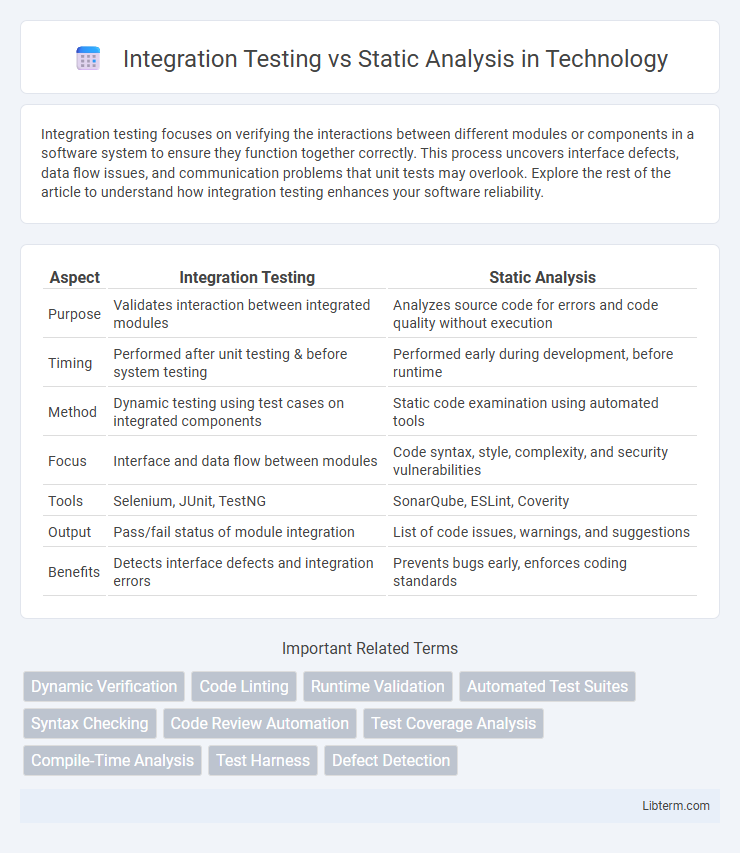Integration testing focuses on verifying the interactions between different modules or components in a software system to ensure they function together correctly. This process uncovers interface defects, data flow issues, and communication problems that unit tests may overlook. Explore the rest of the article to understand how integration testing enhances your software reliability.
Table of Comparison
| Aspect | Integration Testing | Static Analysis |
|---|---|---|
| Purpose | Validates interaction between integrated modules | Analyzes source code for errors and code quality without execution |
| Timing | Performed after unit testing & before system testing | Performed early during development, before runtime |
| Method | Dynamic testing using test cases on integrated components | Static code examination using automated tools |
| Focus | Interface and data flow between modules | Code syntax, style, complexity, and security vulnerabilities |
| Tools | Selenium, JUnit, TestNG | SonarQube, ESLint, Coverity |
| Output | Pass/fail status of module integration | List of code issues, warnings, and suggestions |
| Benefits | Detects interface defects and integration errors | Prevents bugs early, enforces coding standards |
Introduction to Integration Testing and Static Analysis
Integration testing evaluates the interaction between integrated software modules to identify interface defects and ensure combined functionality meets requirements. Static analysis involves examining source code or binaries without execution to detect potential errors, code quality issues, and security vulnerabilities early in the development lifecycle. Both techniques are essential for comprehensive software quality assurance but address different aspects of the development process.
Key Differences Between Integration Testing and Static Analysis
Integration testing evaluates how different software modules interact by executing combined components in a runtime environment to identify interface defects and data flow issues. Static analysis involves examining source code or bytecode without execution, using automated tools to detect coding errors, security vulnerabilities, and compliance violations early in the development cycle. The key difference lies in integration testing's dynamic verification of module interactions versus static analysis's code-centric review for quality and security before runtime.
Purpose and Objectives of Integration Testing
Integration testing aims to verify the interaction and data flow between multiple software modules to ensure they work together correctly as a unified system. Its primary objective is to identify interface defects and issues arising from module integration that unit tests may miss. Unlike static analysis, which focuses on analyzing code without execution to detect syntax errors and code quality issues, integration testing evaluates the dynamic behavior of combined components under various conditions.
Purpose and Objectives of Static Analysis
Static analysis aims to identify code errors, vulnerabilities, and compliance issues early in the development lifecycle by examining the source code without executing it. Its primary objective is to improve code quality, ensure adherence to coding standards, and detect potential security risks before runtime. Unlike integration testing, which validates the interaction between combined modules, static analysis provides automated, early feedback to developers for continuous code improvement.
When to Use Integration Testing vs Static Analysis
Integration testing is essential when verifying the interaction and data flow between multiple software modules to ensure they work together correctly in a runtime environment. Static analysis is most effective early in the development cycle for detecting code quality issues, security vulnerabilities, and compliance with coding standards without executing the program. Use integration testing after unit tests to validate system behavior under real conditions, while static analysis should be employed continuously during coding to prevent defects before runtime.
Advantages of Integration Testing
Integration testing uncovers defects in the interaction between software modules by executing combined components, ensuring seamless functionality across integrated systems. It provides real-time validation of interfaces, workflows, and data exchanges, revealing issues that static analysis cannot detect. This dynamic testing approach enhances system reliability by verifying actual runtime behavior in complex, interconnected environments.
Advantages of Static Analysis
Static analysis offers the advantage of detecting code errors, security vulnerabilities, and potential bugs early in the development lifecycle without executing the program. This method enhances code quality by enforcing coding standards and improving maintainability through automated, consistent reviews. Static analysis tools provide rapid feedback, reduce debugging time, and prevent costly runtime failures that integration testing might miss until later stages.
Common Tools for Integration Testing and Static Analysis
Common tools for integration testing include JUnit, TestNG, and Selenium, which facilitate automated test case execution and environment simulation to ensure components interact correctly. Static analysis tools like SonarQube, ESLint, and FindBugs analyze source code without execution to detect vulnerabilities, code smells, and compliance issues early in the development cycle. Combining integration testing suites with static analysis platforms enhances software quality by identifying runtime defects and code-level problems concurrently.
Challenges and Limitations
Integration testing faces challenges such as complex environment setup, difficulty in isolating defects, and ensuring comprehensive coverage across multiple components. Static analysis limitations include false positives, inability to detect runtime errors, and reliance on predefined rules that may miss context-specific issues. Both methods require complementary approaches to achieve robust software quality assurance.
Best Practices for Combining Integration Testing and Static Analysis
Combining integration testing and static analysis enhances software quality by identifying issues early and validating complex interactions between modules. Best practices include running static analysis tools during continuous integration to detect code vulnerabilities and enforcing coding standards before executing integration tests to verify system behavior. Integrating both methods ensures comprehensive defect detection, reduces debugging time, and optimizes overall development efficiency.
Integration Testing Infographic

 libterm.com
libterm.com